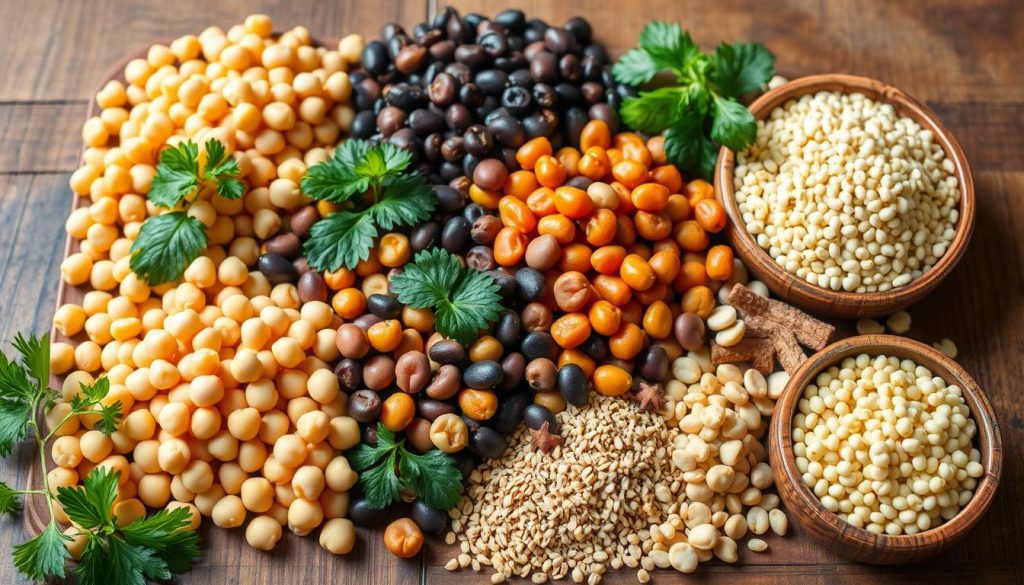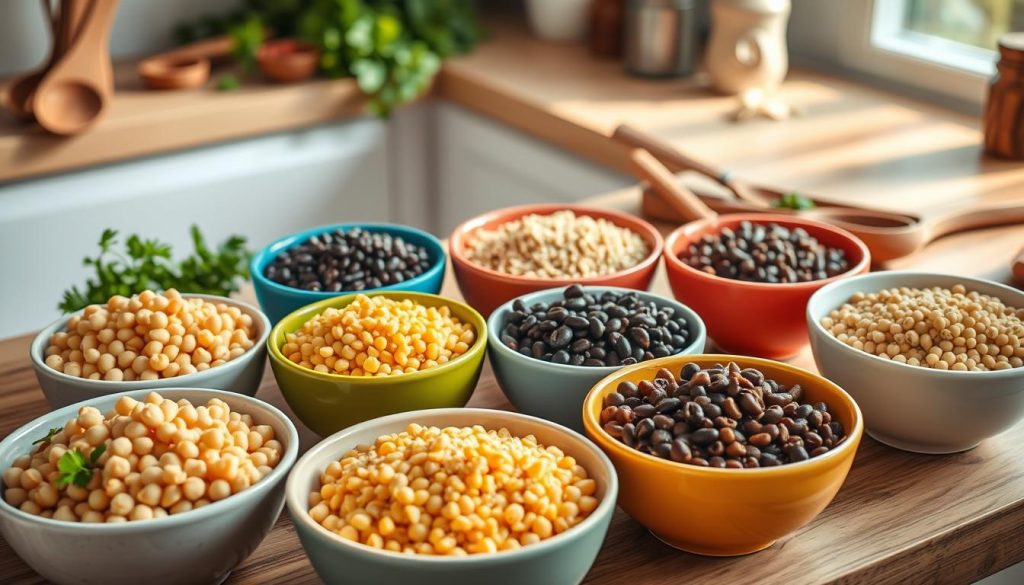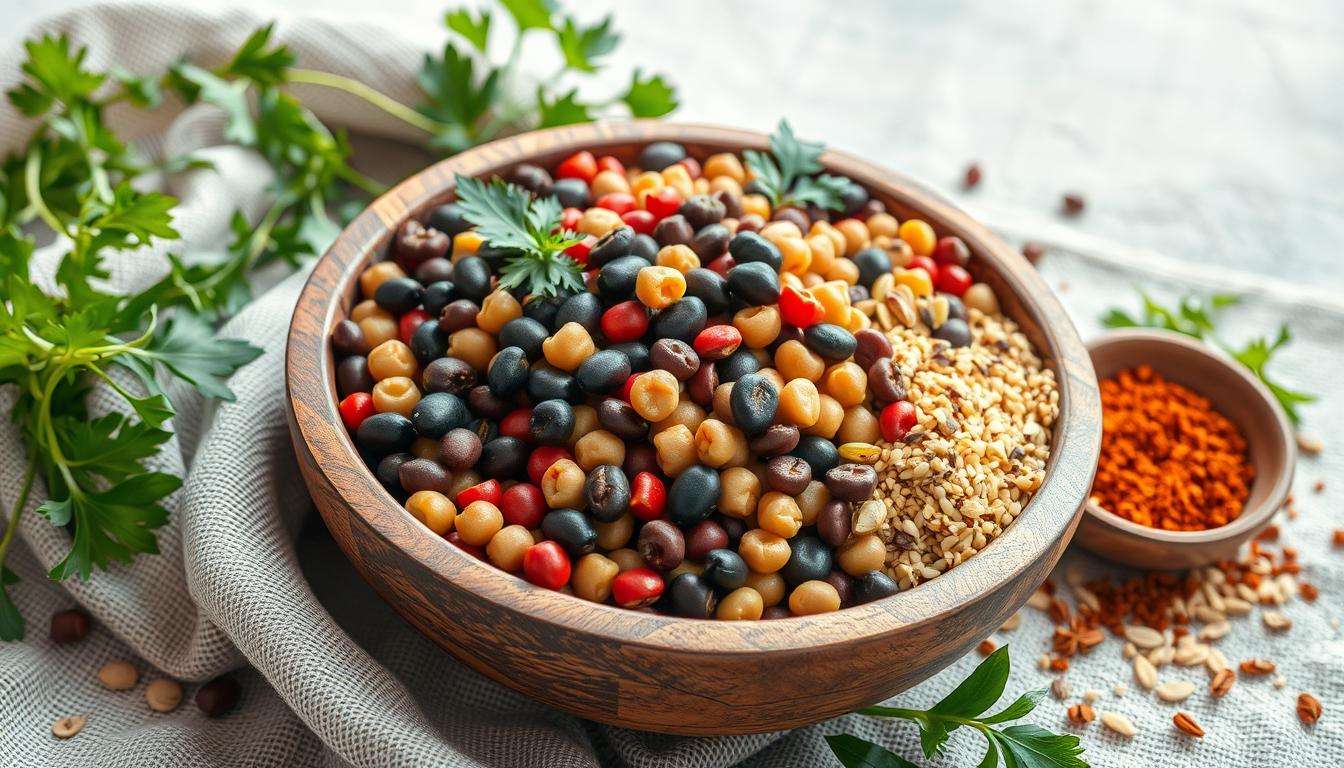In this guide, you’ll find many lentil substitutes and alternatives. These can make your cooking better and meet your nutritional needs. Lentils are great because they’re versatile and full of fiber and protein.
But sometimes, you might want to try something else. Knowing why you want a substitute is key to keeping your meals good.
Let’s explore the different types of lentils, like brown, green, red, and black. Each has its own cooking method and taste. This knowledge helps you easily switch to new ingredients, whether in a stew or salad.
Our top picks for substitutes include Fillo’s seasoned beans and Barilla’s chickpea pastas. They help you make healthy dishes that still taste great.
Understanding Lentils and Their Uses
Lentils are small legumes that are very nutritious. They come in different types, each with its own taste and cooking method. Knowing the different types of lentils is key when making lentil recipes. They can change the dish’s texture and taste.
Adding lentils to your meals can bring many health benefits. They are a great addition to any diet.
Types of Lentils
There are several common types of lentils, like brown, green, red, and black. Each type has its own flavor and use:
- Brown lentils: These are the most common. They have an earthy taste and a firm texture. They’re great in soups, stews, and salads.
- Green lentils: Also known as French lentils, they have a peppery taste. They’re firmer and loved in Mediterranean and Middle Eastern dishes.
- Red lentils: Popular in Indian and Middle Eastern cooking. They’re sweet and nutty, and break down when cooked. Perfect for thickening soups and curries.
- Black beluga lentils: They look like caviar and have a strong, earthy flavor. They’re chewy and good in many dishes.
- Yellow lentils: Known as moong dal, they’re mild and slightly sweet. They’re soft and often used in Indian cooking.
Cooking with Lentils
Cooking lentils is easy and quick. Most types don’t need soaking. To cook them, just boil them in water until they’re tender:
| Type of Lentil | Water to Lentils Ratio | Cooking Time |
|---|---|---|
| Brown Lentils | 2½ – 3 cups water for 1 cup lentils | 35 – 45 minutes |
| Green Lentils | 2½ cups water for 1 cup lentils | 35 – 45 minutes |
| Red Lentils | 1½ cups water for 1 cup lentils | 15 – 30 minutes |
| Black Beluga Lentils | 2¼ cups water for 1 cup lentils | 25 – 30 minutes |
| French (Puy) Lentils | 2½ cups water for 1 cup lentils | 20 – 30 minutes |
Cooked lentils have about 230 calories, 18 grams of protein, and 16 grams of fiber. They add flavor and health benefits to your meals. Use them in soups, stews, or salads for a boost of protein, fiber, and nutrients.
Why You Might Need a Lentil Substitute
Lentils are a common food in many diets. But, you might need to find other options for different reasons. Knowing why you might choose a lentil substitute can help you meet your dietary needs.
Common Reasons for Substituting Lentils
There are several reasons to look for lentil substitutes:
- Availability: Lentils might not be easy to find in your area, so you look for other choices.
- Personal Taste: Some people don’t like the taste or texture of lentils. They need something else that’s nutritious.
- Dietary Restrictions: Health issues or certain diets might mean you need less carbs or more protein.
Understanding Nutritional Needs
Choosing a lentil substitute often depends on your nutritional needs. Lentils have about 18 grams of protein per cooked cup and lots of fiber. If you want to change your protein source or carb intake, picking the right substitute is key.
For example, quinoa or chickpeas are good protein sources that fit dietary restrictions. They also have different amounts of fiber and vitamins that match your health goals.
Top Substitutes for Lentils Guide
Looking to swap out lentils in your meals? You’ve got plenty of options. Many substitutes offer great nutrition, similar taste, and texture. Let’s dive into some top picks to help you choose wisely in the kitchen.
Using Split Peas as a Lentil Alternative
Split peas are a great lentil substitute, thanks to their nutritional match. They take about 30-40 minutes to cook, a bit longer than some lentils. But they break down well, making them blend into dishes like lentils do.
They’re packed with fiber and protein, perfect for soups and stews. This makes them a versatile choice for cooking.
Chickpeas: A Versatile Lentil Substitute
Chickpeas are a standout lentil alternative, fitting into many cuisines. They need soaking and cooking for longer than lentils. Enjoy them in salads, curries, or blended into dips like hummus.
Rich in protein, chickpeas add a hearty bite and creamy texture to dishes. Their unique flavor boosts many recipes, making them a pantry staple.
Utilizing Quinoa for a Nutritious Swap
Quinoa is known for its complete protein, making it a nutritious swap for lentils. It cooks quickly, in about 15-20 minutes, and has a fluffy texture. Quinoa soaks up flavors, enhancing any meal.
Adding quinoa to your diet gives you a strong protein source and essential vitamins and minerals. It’s a tasty alternative when lentils are out of reach.

| Substitute | Cooking Time | Protein per Cup | Fiber per Cup | Notes |
|---|---|---|---|---|
| Split Peas | 30-40 minutes | 16g | 13g | Great in soups and stews, blends well. |
| Chickpeas | Varies (requires soaking) | 14g | 12g | Versatile in many dishes, including salads and curries. |
| Quinoa | 15-20 minutes | 8g | 5g | Absorbs flavors well, excellent protein source. |
Cooking Tips for Lentil Substitutes
Exploring cooking lentil substitutes means knowing how to adjust recipes. Each substitute cooks differently and tastes unique. It’s key to adjust your cooking method based on the substitute you choose. Here are some tips to make your cooking smoother and more fun.
Adapting Cooking Times
Each lentil substitute cooks at a different pace. For example, split peas take longer than lentils. Here’s a quick guide to cooking times:
| Substitute | Cooking Time |
|---|---|
| Split Peas | 30-40 minutes |
| Chickpeas (cooked) | 20-30 minutes (if dry, soak overnight) |
| Quinoa | 15 minutes |
| Brown Lentils | 20-30 minutes |
Cooking times can change with different cooking methods. Pressure cooking can cut down these times a lot, without losing flavor or texture.
Flavor Pairing Suggestions
Think about flavor pairings when adjusting recipes. The right herbs and spices can make a dish shine. Here are some ideas:
- Split Peas: Try garlic, thyme, and bay leaves for a cozy soup.
- Chickpeas: Mix cumin, coriander, and paprika for tasty salads or curries.
- Quinoa: Add lemon zest, fresh herbs like parsley or mint, and roasted veggies for a lively side dish.
Trying out these flavor combinations can lead to dishes that taste great and are good for you.

How to Incorporate Substitutes into Your Recipes
Adding substitutes to your meals can make them taste better and be healthier. You can use different legumes and grains in lentil recipes. This makes salads, soups, and stews more interesting. Here are some creative ways to add these substitutes to your cooking.
Salads and Bowls
Salads can be more filling and nutritious with substitutes like split peas, chickpeas, or quinoa. These ingredients add texture and boost nutrition. Here are some ideas:
- Top mixed greens with roasted chickpeas for a protein boost.
- Mix quinoa with vegetables, herbs, and a light dressing for a refreshing grain bowl.
- Combine split peas with a lemon vinaigrette and diced cucumbers for a zesty salad option.
Soups and Stews
Substitutes in soups and stews make them delicious and filling. Split peas have a similar texture and taste. Chickpeas add creaminess, and quinoa is a gluten-free option. Try these ideas for your next meal:
- Make a hearty pea soup by simmering split peas with vegetables and herbs.
- Prepare a creamy chickpea stew with tomatoes, garlic, and spinach for a comforting meal.
- Use quinoa as a base for vegetable soup, allowing it to soak up the flavors.
By trying these substitutes, your salads and soups can become versatile and nutritious. Adjust cooking times based on the substitutes you use. This ensures your dishes are hearty and flavorful.
| Ingredient | Calories (per 1/4 cup) | Protein (g) | Key Nutrients |
|---|---|---|---|
| Lentils | 169 | 12 | Iron, Calcium, Fiber |
| Split Peas | 120 | 8 | Fiber, Iron |
| Chickpeas | 150 | 10 | Folate, Fiber |
| Quinoa | 160 | 6 | Magnesium, Iron |
Conclusion
This guide on lentil substitutes shows how versatile and nutritious these alternatives are. Using chickpeas, split peas, and quinoa keeps your dishes tasty and healthy. It shows many options for making delicious meals that fit different diets.
Learning how to cook these substitutes is key. Knowing the right cooking times and flavors makes your dishes a hit. Trying new ingredients lets you create meals that are both tasty and good for you.
So, don’t be afraid to try out different substitutes. It can change your daily meals and make cooking more fun. Exploring new ingredients can be a great way to improve your health and enjoy your food more.
Source Links
- https://www.cspinet.org/article/best-beans-jumpstart-quick-easy-and-healthy-meals
- https://www.themediterraneandish.com/how-to-cook-lentils/
- https://86lemons.com/best-dried-lentils/
- https://www.fao.org/pulses-2016/blog/everything-you-need-to-know-about-lentils/en/
- https://www.plantempoweredwellness.com/articles/your-guide-to-lentils-and-what-to-do-with-them
- https://lentillovingfamily.com/types-of-lentils/
- https://balancingbowls.com/lentils/
- https://www.webstaurantstore.com/blog/4284/types-of-lentils.html?srsltid=AfmBOoobX1XDbAFMVZZu06gykgawHGaUdrGHwd2DfflJNQRlKPKyOmgJ
- https://forums.digitalspy.com/discussion/1593615/puy-lentil-substitute
- https://www.getsetvegan.com/brown-lentils-substitute/
- https://plantbasedonabudget.com/a-complete-guide-to-lentils/
- https://ohmyveggies.com/a-comprehensive-guide-to-lentils/
- https://cookieandkate.com/perfect-lentils-recipe/
- https://missnutritiouseats.com/how-to-cook-lentils-perfectly-recipe-tips/
- https://www.simplyquinoa.com/how-to-cook-lentils-ultimate-guide/
- https://www.slenderkitchen.com/article/the-beginners-guide-to-lentils
- https://www.vegetariantimes.com/plant-based-101/ingredient-substitution-guide/
- https://scopeblog.stanford.edu/2024/12/19/dietary-guidelines-nutrition-what-americans-should-eat/
- https://pmc.ncbi.nlm.nih.gov/articles/PMC9370574/
- https://discover.texasrealfood.com/swap-and-savor/how-to-substitute-red-lentils-for-green-lentils
